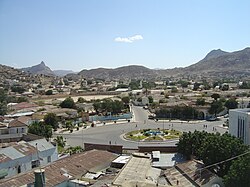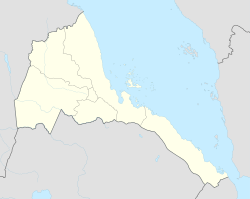Cheren
|
Keren كرن ከረን |
|
|---|---|
| City | |
 |
|
| Location in Eritrea | |
| Coordinates: 15°46′40″N 38°27′29″E / 15.77778°N 38.45806°E | |
| Country |
|
| Region | Anseba |
| District | Keren |
| Elevation | 1,590 m (5,220 ft) |
| Population (2012) | |
| • City | 82,198 |
| • Metro | 146,483 |
Keren (Ge'ez: ከረን Arabic: كرن or كيرين), formerly known as Cheren and Sanhit, is the second-largest city in Eritrea. It is situated around 91 kilometres (57 mi) northwest of Asmara at an elevation of 1,390 metres (4,560 ft) above sea-level. The town sprawls on a wide basin surrounded by granitic mountains on all sides. It serves as the capital of the Anseba region, and is home to the Bilen people.
Keren grew around the Eritrean Railway to Asmara. The railway was later dismantled because of the war, although there are plans to rebuild it. It is an important commercial centre and was the scene of regular battles in both World War II and the Eritrean War of Independence. Keren was the site of a key battle between Italian and British troops in February – March 1941.
As of 2010, Keren has a population of around 146,483 inhabitants. Residents belong to various, mainly Afroasiatic-speaking ethnic groups, of which the Bilen and Tigre peoples are predominant. The Tigrigna also have a presence.
Keren has a hot semi-arid climate (Köppen BSh), with two main seasons. There is a short monsoonal wet season from June to September and a length dry season covering the rest of the year. Vis-à-vis most hot semi-arid climates in northern Africa like those of Niamey or N'Djamena, Keren’s climate is much less extreme due to the city’s higher altitude. Nonetheless, in the period between March and mid-June immediately before the wet season begins, afternoon temperatures still average over 32.2 °C (90 °F) for around three months. Following the wet season, temperatures remain very warm to hot during the day, but during the mornings become comfortably cool.
...
Wikipedia

